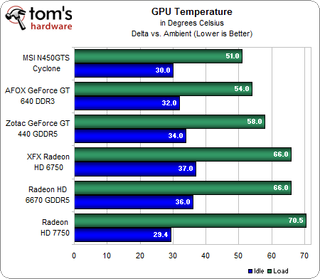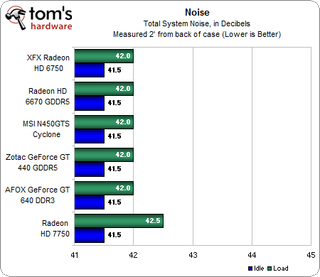Nvidia GeForce GT 640 Review: Cramming Kepler Into GK107
Afox sent us its rendition of the new GeForce GT 640, based on Nvidia's GK107 GPU. This one slots in under the existing GeForce GTS 450 to do battle with AMD's Radeon HD 6670. Does the Kepler architecture deliver, or is a $100 price target too high?
Power, Temperature, And Noise Benchmarks
Of all of the cards tested in this review, only the Radeon HD 6670 GDDR5 and Radeon HD 7750 are reference models. Keep this in mind when interpreting the following charts, since noise, power, and thermal measurements are affected by non-reference voltages and coolers.

Nvidia’s GeForce GT 640, based on the 28 nm GK107 GPU, leads the pack in power consumption (though the Radeon HD 6670 GDDR5 and 7750 aren’t far behind). Note the high idle power use of the Radeon HD 6750.

Temperatures are definitely affected by aftermarket coolers, making this a difficult comparison. However, the new GeForce card runs coolly, despite its simple reference-based cooler. The small, single-slot Radeon HD 7750 struggles in comparison.

All of the cards we tested are acoustically-tolerable. The Radeon HD 7750 is a little louder than the rest of the pack under load, but it’s not problematic by any stretch.
Stay on the Cutting Edge
Join the experts who read Tom's Hardware for the inside track on enthusiast PC tech news — and have for over 25 years. We'll send breaking news and in-depth reviews of CPUs, GPUs, AI, maker hardware and more straight to your inbox.
Current page: Power, Temperature, And Noise Benchmarks
Prev Page Benchmark Results: Diablo III Next Page GeForce GT 640 Means Business...At The Right Price-
Would like to see a GDDR5 version of this card. Be interesting to see the performance difference.Reply
-
rolli59 At least we now have a card from Nvidia that can be called min gaming card and be installed on machines with low power PSU's.Reply -
-Fran- Darn... nVidia, step up the game in this segment!Reply
This doesn't even get close to the card placed just 10 bucks above.
Cheers! -
dragonsqrrl The DDR3 is without a doubt holding this card back. With a maximum memory bandwidth of just 28.5 GBps I'm surprised the card performed as well as it did. I'm just not sure what Nvidia was thinking. At 900MHz, GK107 would probably be capable of easily outperforming the GTS450. Was it cost savings, or perhaps a TDP limitation that made them choose DDR3 over GDDR5? If keeping below a 75W TDP was the problem, why not just use 1GB GDDR5 instead? Or even slightly lower the core clock if necessary? It probably still would've resulted in better performance.Reply -
Onus Almost, nVidia, almost!Reply
1. With the GT440 and GT240 offering it, I can't believe someone won't quickly release a GDDR5 version. With such an obvious improvement that would be, it does not bode well for yields or other costs that DDR3 had to be used, and the card still has a $100 initial price. Can it come down to where it needs to be without becoming a "loss-leader?"
2. Pretty decent settings were used in the charts. Considering how good most modern games look even cut down to "medium" settings, that HD7750 at or near the top of the charts makes people who insist you need a $300 graphics card to play games look silly. This makes me wonder all the more what this new card could do with GDDR5, assuming it's economically feasible. Of course if it isn't, then this card simply loses except in that niche market that wants to run three monitors.
3. I think the word you were looking for in reference to the absence of a PCIE power connector is "eschew."
4. Interesting, I noted that the box image is of a Seraphim from the game Sacred 2. Might that game be included with the card, is it meant to advertise that the card supports PhysX (which Sacred 2 will use), or is there a copyright lawsuit on the way? -
dalethepcman If this card retails for the $100 this article is implying then its a really tough sell. The 7750 outperforms the 640 in every way except loaded power consumption and for a meager $10 more....Reply -
bin1127 wow... is this card going to sell for $75?Reply
I think nvidia doesn't want to kill amd outright and comes up with these really bad products. -
rohitbaran cumi2k4where's the 6770 in this benchmark?6770 is slower than 7750. It is also older gen. Why put that?Reply -
songorocosongo As always Nvidia only makes good products for the high-end market and forgets about low-end or just makes crappy ones. This shouldn't surprise anyoneReply
Most Popular

